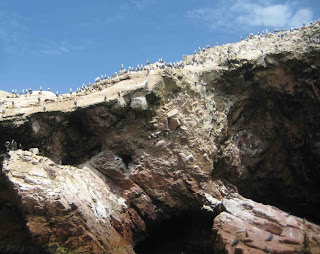GENERAL
SAN MARTIN and PISCO Stopover
Including
the PERU'S GALAPAGOS: The BALLESTAS ISLANDS Tour
Thursday
5th April 2012
After
experiencing quite the ocean swell as the MS VEENDAM was
approaching GENERAL SAN MARTIN, the deepwater port for the
town of Puerto PISCO and the first stop for the ship in Peru,
docking was a calm and quite a simple procedure.
The landscape that greeted us at first light was totally sandy and desert like as this was also part of the ATACAMA DESERT that we had first seen on the outskirts and surroundings of ARICA, Chile.
GENERAL SAN MARTIN is located on the Paracas Peninsula, which is also the location of the “Reserva Nacional de Paracas”, once home to the “Moche” people, one of the most developed coastal civilisations in ancient Peru and lived in a mini empire with a kingdom that lasted some 6 centuries.
The word “paracas” means “storm of the sands” and refers to the windstorms that can (and usually do) arise each afternoon. Although it was hazy, the weather stayed mostly sunny with some high clouds.
We travelled there by speed boat, taken directly from the side of the MS VEENDAM and after initially stopping off at a rock at the end of the harbour to take our first views of the Cormorants and Pelicans.
We then continued on up the coast so as to view the shoreline full of coastal caves (also teaming with life) and an “ancient symbol” of a “sacred cactus” design, that had been etched into the sand on a hillside.
It is not known who made these etchings nor when, but as there is virtually no rainfall in this ATACAMA DESERT in this area of Peru, they had lasted hundreds if not thousands of years.
The Paracas Peninsula has several offshore islands including Isla Sangallan, Islas Faralones and Isla Blanca.
But the most important of these are the ISLAS BALLESTAS, location of the “Reserva Nacional de Islas Ballestas”, which is operated by the Ministry of the Environment within the Government of Peru.
The ISLAS BALLESTAS are three
largish islands with some fascinating rock formations with many caves and arches created by water erosion.
The ISLAS BALLESTAS are the home to so many different species from common Seals to black and brown Sea Lions, from Humboldt Penguins, (these having migrated from Antarctica by passing Chile, with this colony having just a single black stripe on their chest) to both black and white cormorants.
There were also Peruvian Boobies to Aztec Terns plus Starfish and Jellyfish and Crabs and several varieties of mussels and types of seaweed.
Each of them seemed to find there own little ledge or part of beach on these islands to rest and/or sleep upon. And, as the waters around the islands are cold, the birds have to fly out to sea to catch the fish they need to feed upon.
Guano is collected from these islands (and the smell was quite pungent and with is the whole time we were there) once a year and the collection is managed by a special “Guano Department” within the Ministry of the Environment within the Government of Peru.
This is then turned into fertiliser and sold mainly to both Mexico and the United States of America, with some finding its way to Australia and New Zealand as well as Europe.
The ISLAS BALLESTAS were an
amazing place to visit and to be able to see all these different
species in their natural habitats by not disturbing them was an
absolute delight.
On the way back to the MS VEENDAM from the ISLAS BALLESTAS we literally saw a “sea of birds” on the horizon. Some floating while feeding and some flying after feeding.
On a short land visit after the speed boat ride to the ISLAS BALLESTAS we were able to see some views across the bay to Puerto PISCO as well as see some more black and white Cormorants and Pelicans at the end of the pier in the Port of GENERAL SAN MARTIN.
On the way back to the MS VEENDAM from the ISLAS BALLESTAS we literally saw a “sea of birds” on the horizon. Some floating while feeding and some flying after feeding.
On a short land visit after the speed boat ride to the ISLAS BALLESTAS we were able to see some views across the bay to Puerto PISCO as well as see some more black and white Cormorants and Pelicans at the end of the pier in the Port of GENERAL SAN MARTIN.
And as the MS VEENDAM
prepared to depart GENERAL SAN MARTIN, Peru the sun was
covered in a thin layer of cloud over the ATACAMA DESERT, we
were left with a memory of earlier days with the view of an old steam
train.






























































No comments:
Post a Comment